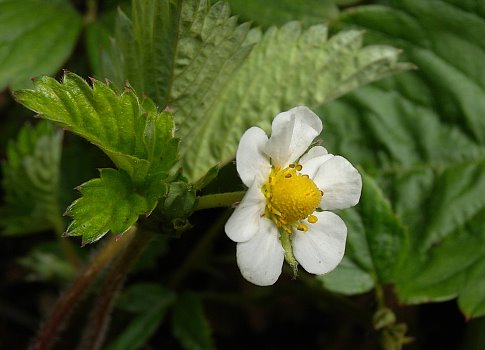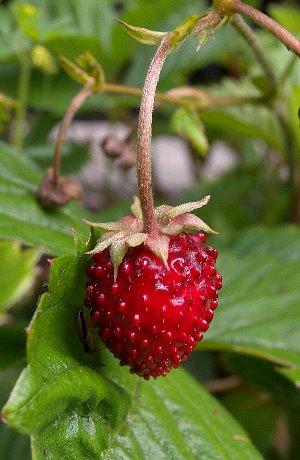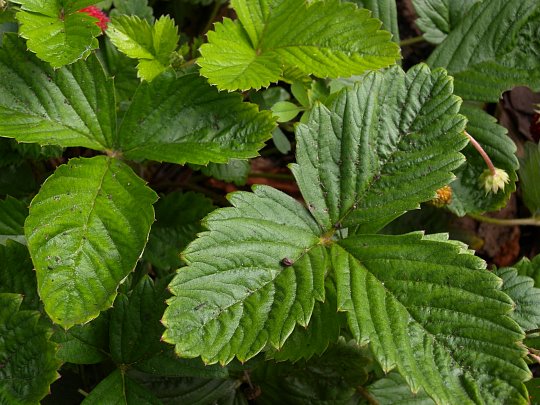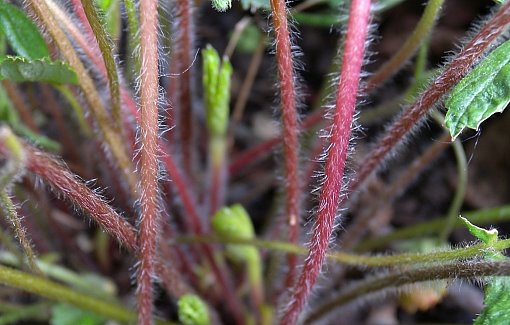
At the apex of each stalk, there develops a branching cluster of about 2-5 flowers. Each flower is about ½" across, consisting of 5 white petals, a calyx with 5 green sepals that are joined together at the base, a dense cluster of light green to pale yellow pistils, and a ring of 20-35 stamens with yellow anthers. The peduncle and pedicels of the flowers are light green or light reddish green and covered with appressed hairs. One or two small leafy bracts are located at the base of inflorescence. The blooming period occurs from late spring to mid-summer, lasting 1-2 months. Afterwards, fertile flowers are replaced by small fruits that become a little less than ½" long at maturity (typically 8-10 mm. in length); they are bright red, glabrous, and ovoid to ovoid-conical in shape (although they typically hang upside down). Numerous reddish achenes are scattered across the surface of the fruit; they are not sunken below the surface in pits. Some cultivars of this plant produce white mature fruits, rather than red. The fleshy interior of the fruit varies in flavor, depending on the cultivar, but it is often bland. At the base of each fruit, the sepals of the persistent calyx are either spreading or reflexed; they do not adhere to the
 surface of the fruit. The
root system consists of a dense
vertical crown with fibrous roots. Occasionally during the summer, low
stolons up to 1' or more in length are produced from the crown. Where
the nodes of the stolons touch moist ground, they can produce new
plantlets. It should be noted, however, that some cultivars of this
plant don't produce any stolons. Most of the foliage dies down during
the winter, although a few low leaves may persist near the crown.
surface of the fruit. The
root system consists of a dense
vertical crown with fibrous roots. Occasionally during the summer, low
stolons up to 1' or more in length are produced from the crown. Where
the nodes of the stolons touch moist ground, they can produce new
plantlets. It should be noted, however, that some cultivars of this
plant don't produce any stolons. Most of the foliage dies down during
the winter, although a few low leaves may persist near the crown.Cultivation: The preference is full sun to light shade, moist to dry-mesic conditions, and soil containing fertile loam or sandy loam. Cool to warm summer temperatures are preferred, rather than hot.
Range & Habitat: The introduced European Woodland Strawberry has naturalized in Lake County in NE Illinois, where it is rare (see Distribution Map). This plant is native to Eurasia and introduced into North America primarily as an ornamental garden plant. It is still widely cultivated. Typical habitats of naturalized plants in Illinois and elsewhere include open woodlands, roadsides, weedy meadows, and fields.
Faunal Associations: The floral-faunal relationships of the European Woodland Strawberry are probably very similar to those of the American Woodland Strawberry (Fragaria vesca americana) and the common Wild Strawberry (Fragaria virginiana). Small bees, miscellaneous flies, butterflies, and skippers occasionally visit the flowers for either nectar or pollen. A fair number of insects feed on the foliage, roots, and fruits of strawberry plants. This includes such species as Altica ignita (Strawberry Flea Beetle), Paria fragariae (Strawberry Rootworm), Anthonomus signatus (Strawberry Bud Weevil), Otiorhynchus ovatus (Strawberry Root Weevil), Otiorhynchus rugostriatus (Rough Strawberry Root Weevil), Stelidota geminata (Strawberry Sap Beetle), Chaetosiphon fragaefolii (Strawberry Aphid), and caterpillars of Pyrgus centaurae wyandot (Grizzled Skipper). In addition to these insects, the caterpillars of several moths feed on various parts of strawberry plants. Examples include Ancylis comptana fragariae (Strawberry Leafroller), Synanthedon bibionipennis (Strawberry Crown Borer), and Achyra rantalis (Garden Webworm); see the Moth Table for a more complete listing of species.

Many vertebrate animals eat the fruits of strawberry plants and spread the seeds to new locations. These fruit-eating species include various birds (Ruffed Grouse, Ring-Necked Pheasant, American Crow, White-Throated Sparrow, Brown Thrasher, Eastern Towhee, Veery, and Robin), several mammals (Opossum, Eastern Chipmunk, Franklin Ground Squirrel, Red Squirrel, White-Footed Mouse, and Woodland Deer Mouse), and even some land turtles (Eastern Box Turtle and Wood Turtle). The foliage is edible to such hoofed mammalian herbivores as deer, cattle, horses, and sheep.
Photographic Location: A garden at the Urbana Free Library in Urbana, Illinois.

Comments: The European subspecies of Woodland Strawberry (Fragaria vesca vesca) is cultivated for its attractive foliage, flowers, and fruit. Different cultivars of this subspecies can vary in regards to the appearance of their fruits, length of bloom, and tendency to form stolons. It is somewhat difficult to distinguish the American subspecies of Woodland Strawberry (Fragaria vesca americana) from its European counterpart. In general, the American subspecies has leaves that are more thin and delicate, appressed hairs along its petioles and flowering stalks (rather than spreading hairs), slightly smaller flowers, and more conical and elongated fruits (although this last characteristic is less reliable). Notwithstanding these distinctions, the traits of these two subspecies can overlap to some extent. Regardless of subspecies, the Woodland Strawberry can be distinguished from the Wild Strawberry (Fragaria virginiana) by having the terminal teeth of its leaflets as long or longer than the adjacent teeth, spreading or reflexed sepals on its fruits (rather than appressed), achenes on the surface of its fruits rather than enclosed in pits, and fruits that are more elongated and conical in shape (as opposed to globoid or ovoid in shape). Interestingly, the Woodland Strawberry and Wild Strawberry cannot hybridize with each other because of genetic incompatibility. More specifically, the Woodland Strawberry is diploid with 2 sets of chromosomes, while the Wild Strawberry is octoploid with 8 sets of chromosomes.